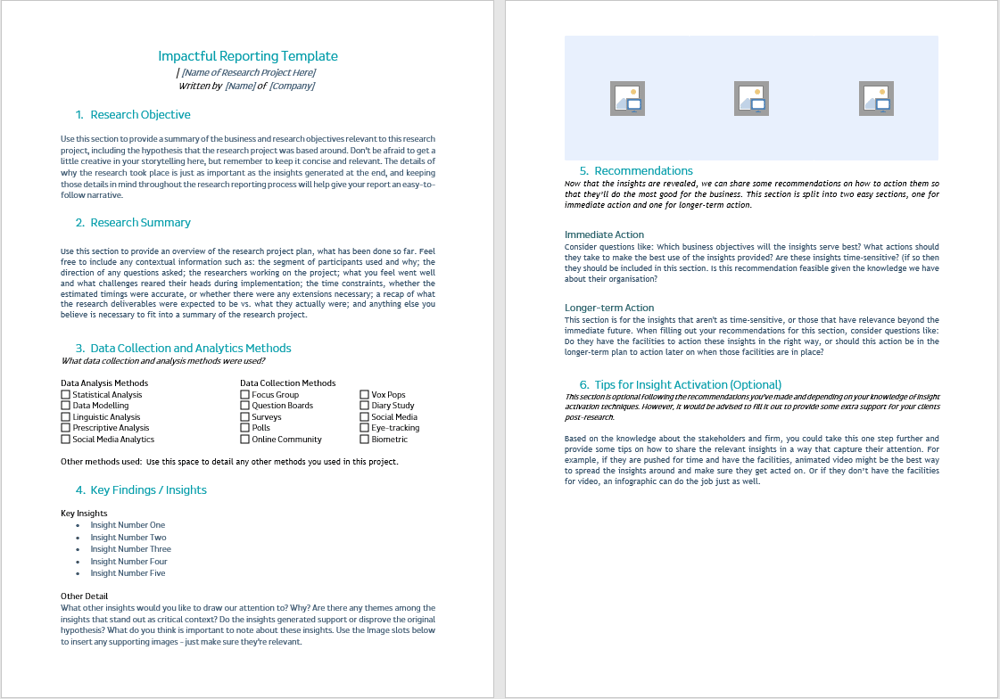Market research insights have the power to transform a project, product, service, and even a whole organisation, but they sometimes miss their mark. This isn’t the fault of the insights themselves, but are most likely a result of how they’re reported.
Market research reports are and have always been, long, wordy, and full of data tables and graphs. But there are tricks we can use to take insights reporting to the next level.
How To Create an Impactful Report
Insights are inherently engaging, and impactful to their core when linked with the right insight activation strategies. But there are ways in which we can ensure this impact, even in a wordy written report.
Psychology
When presenting insights, think about the person or people who need them. Who are they? What time-pressure are they under? How do they normally consume content? What are their attention spans like?
Typically, the audience's’ attention drops to zero after just ten minutes of a presentation, so making sure that any insights that need to be communicated are able to either be communicated through a quick scan of a lengthy report or keep the whole report concise enough to be communicated in ten minutes or less.
Whether this is through a presentation, written, or video report, these questions and more will help you define exactly how to present your insights so they have the best chance of landing well, informing the original hypothesis and impacting the decisions of those stakeholders to the best of their ability.
Storytelling
Storytelling isn’t just about weaving fairy stories from nothing, storytelling techniques in market research is a thorough piecing together of insights like puzzle pieces to help build up the fullest picture we possibly can.
Following the structure of the template, all insight professionals can be sure to write a report with an easy-to-follow narrative, with each section flowing into the other and providing vital insight to inform the next one. As we’re hardwired to engage with stories, especially stories with a simple but effective narrative, this can be sure to help communicate the insights generated in a way that maximises the resulting impact.
But words on their own also have a power to capture and hold the audience’s attention; by using compelling creative language rather than the standard formal language typically found in written reports, we can hook the audience into the story of the research project, the story of the customer experience, and the story of how to make good use of the insight generated so as to make the best impact possible.
Imagery and Art
Images are inherently more instantly engaging than words, as they’re easier to instantly understand and dig deeper into. We have just discussed the intense power of words that enable us to explore words, but I bet you’ve heard the phrase ‘a picture is worth ten thousand words’. A national advertising manager first published this phrase in the 1920s, which accurately captures our predisposition to look to pictures to tell the story instead of the words that follow them.
Even now, we slavishly look to pictures on the front cover of a book to gain a sense to what the story is about, judging a book by it’s cover all the time when browsing for our next read. Inserting images into an insights report will automatically draw attention to the most important parts, making sure they’re relevant to the section they’re in will help hook the audience into the text provided too. This is why we’ve put spaces for three images in this report in the ‘key findings and insights’ section, so that if any skim reading does occur, the attention is drawn to the section that contains the all-important impactful insights, allowing them the best chance of discovery and action.
Impactful Reporting Template
For the stakeholders who are more traditional in their ways, this template provides a good structure to form your report. Starting with a summary of the research objective and the research process taken is a good way to set the scene, give the relevant context necessary to set the generated data and insights into. While keeping these parts concise, there will be lots of relevant information to put into these two sections, to name a few:
- Research objectives
- Timescales (both initial estimates and actual outcomes)
- Researchers involved
- Participants involved (segmentations, demographic overview, etc.)
- Data collection and analysis methods used
After this background information is shared, the insights you generated can now take centre stage. This should be the main focus of your report, with the insights stated clearly in a place that makes sure they’re unmissable – any other information that informs the insights can be detailed below, to further inform stakeholders and key decisions. But this should not be where you place your recommendations. Keep the insights and recommendations in separate sections so they can inform one another, but not get mixed up.
Each section in this template contains an editable text space, so you can insert your own research objectives, summary, insights, recommendations, etc. into the template provided. While basic, this template can provide a great starting point for those wanting to help make their insight reports more impactful.
However, for those wanting to take a more creative approach, then this template can be used as a note-taking exercise to inform the report, structurally and content-wise, making sure you’ve got all the information needed and translate it to other mediums for the final report.
Insight reporting is the natural last stage of the research process for researchers, but not for in-house insight professionals and stakeholders – that would be insight activation. That is why there is an optional last section to fill out. For those going the extra mile, providing tips for insight activation strategies and techniques can help the right stakeholders action those insights in the right way at the right time, so we can give them the best chance of making an impact.


















